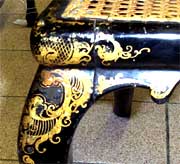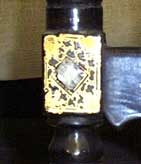Victorian Papier Mache
The Victorians loved to experiment with new materials and one of their favourites was papier mache. By the time Queen Victoria came to the throne, there were at least 25 companies producing papier mache items.
The most common pieces are trays, workboxes, inkstands, face screens, snuff boxes and letter holders. Eventually they moved on to larger items and furniture such as firescreens, chairs and tables, bookcases – even wardrobes and beds!
Nearly always the characteristic black, but occasionally in red or green, the pieces were very ornately decorated with flowers, birds and patterns – frequently embellished in gold. Some of the finer pieces were inlaid with shimmering mother-of-pearl shell.
Jennings and Bettridge are the name most people associate with this period. The Birmingham company had shops in New York as well as London; producing some of the finest papier mache items of all time. Many are now prized collector’s items or museum pieces today.
Papier Mache Production
The making of papier mache items, in particular the pieces of furniture, involved many hours of work and relied upon an almost limitless supply of cheap labour. Very large sheets of black paper were pasted on both sides and firmly pressed over greased moulds. (After having been dipped in large shallow vats of tar spirit and linseed oil). Care was taken to smooth out the surface and remove any trapped air bubbles.
After 2 or 3 layers had been applied, the edges would be trimmed and the item baked in a hot oven. The object would be built up in this way, continually repeating the three layers and baking until the final thickness was met. Some articles had as many as 100 layers of paper by the time they were finished!
Once thoroughly dry, the item was saturated in linseed oil and baked in a very hot oven for many hours to make it hard and water-resistant.
Victorian Papier Mache Chair
This chair is a perfect example of English Victorian papier mache furniture. The chair is beautifully decorated with mother-of-pearl shell, colourful flowers and gold paint.

- English Victorian papier mache chair

- Close-up showing the detail of the mother-of-pearl inlay
Chair decoration
To decorate this lovely chair, the first thing they would have done would have been to cut the mother-of-pearl flakes to shape, soften them, then fix them in position on the chair. The black laquering was then built up around the shell pieces in layers. This close-up photo shows the detail of the mother-of-pearl inlay.
This black laquer was made up of amber, linseed oil, resin and asphaltum (thinned with turpentine). Asphaltum (or “Jewish glue”) was a bitumous substance from the Dead Sea. These layers were fixed by slow baking and long, hard polishing.

- Close-up of gold decoration on top of leg

- Close-up of decoration at the base of the chair back

